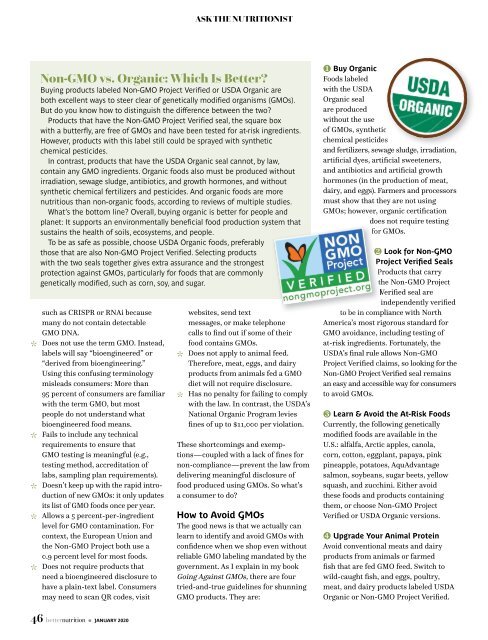You also want an ePaper? Increase the reach of your titles
YUMPU automatically turns print PDFs into web optimized ePapers that Google loves.
ASK THE NUTRITIONIST<br />
Non-GMO vs. Organic: Which Is <strong>Better</strong>?<br />
What’s the bottom line? Overall, buying organic is better for people and<br />
sustains the health of soils, ecosystems, and people.<br />
To be as safe as possible, choose USDA Organic foods, preferably<br />
those that are also Non-GMO Project Verified. Selecting products<br />
with the two seals together gives extra assurance and the strongest<br />
protection against GMOs, particularly for foods that are commonly<br />
genetically modified, such as corn, soy, and sugar.<br />
such as CRISPR or RNAi because<br />
websites, send text<br />
many do not contain detectable<br />
messages, or make telephone<br />
GMO DNA.<br />
calls to find out if some of their<br />
Does not use the term GMO. Instead, food contains GMOs.<br />
*<br />
labels will say “bioengineered” or<br />
*<br />
“derived from bioengineering.”<br />
Using this confusing terminology<br />
misleads consumers: More than<br />
diet will not require disclosure.<br />
95 percent of consumers are familiar<br />
*<br />
with the term GMO, but most<br />
people do not understand what<br />
bioengineered food means.<br />
Fails to include any technical<br />
*<br />
requirements to ensure that<br />
GMO testing is meaningful (e.g.,<br />
testing method, accreditation of<br />
labs, sampling plan requirements).<br />
Doesn’t keep up with the rapid introduction<br />
of new GMOs: it only updates<br />
*<br />
its list of GMO foods once per year.<br />
Allows a 5 percent-per-ingredient<br />
*<br />
level for GMO contamination. For<br />
context, the European Union and<br />
the Non-GMO Project both use a<br />
0.9 percent level for most foods.<br />
Does not require products that<br />
*<br />
need a bioengineered disclosure to<br />
have a plain-text label. Consumers<br />
may need to scan QR codes, visit<br />
46 • JANUARY <strong>2020</strong><br />
Buying products labeled Non-GMO Project Verified or USDA Organic are<br />
both excellent ways to steer clear of genetically modified organisms (GMOs).<br />
But do you know how to distinguish the difference between the two?<br />
Products that have the Non-GMO Project Verified seal, the square box<br />
with a butterfly, are free of GMOs and have been tested for at-risk ingredients.<br />
However, products with this label still could be sprayed with synthetic<br />
chemical pesticides.<br />
In contrast, products that have the USDA Organic seal cannot, by law,<br />
contain any GMO ingredients. Organic foods also must be produced without<br />
irradiation, sewage sludge, antibiotics, and growth hormones, and without<br />
synthetic chemical fertilizers and pesticides. And organic foods are more<br />
nutritious than non-organic foods, according to reviews of multiple studies.<br />
planet: It supports an environmentally beneficial food production system that<br />
Does not apply to animal feed.<br />
Therefore, meat, eggs, and dairy<br />
products from animals fed a GMO<br />
Has no penalty for failing to comply<br />
with the law. In contrast, the USDA’s<br />
National Organic Program levies<br />
fines of up to $11,000 per violation.<br />
These shortcomings and exemptions—coupled<br />
with a lack of fines for<br />
non-compliance—prevent the law from<br />
delivering meaningful disclosure of<br />
food produced using GMOs. So what’s<br />
a consumer to do?<br />
How to Avoid GMOs<br />
The good news is that we actually can<br />
learn to identify and avoid GMOs with<br />
confidence when we shop even without<br />
reliable GMO labeling mandated by the<br />
government. As I explain in my book<br />
Going Against GMOs, there are four<br />
tried-and-true guidelines for shunning<br />
GMO products. They are:<br />
❶ Buy Organic<br />
Foods labeled<br />
with the USDA<br />
Organic seal<br />
are produced<br />
without the use<br />
of GMOs, synthetic<br />
chemical pesticides<br />
and fertilizers, sewage sludge, irradiation,<br />
artificial dyes, artificial sweeteners,<br />
and antibiotics and artificial growth<br />
hormones (in the production of meat,<br />
dairy, and eggs). Farmers and processors<br />
must show that they are not using<br />
GMOs; however, organic certification<br />
does not require testing<br />
for GMOs.<br />
❷ Look for Non-GMO<br />
Project Verified Seals<br />
Products that carry<br />
the Non-GMO Project<br />
Verified seal are<br />
independently verified<br />
to be in compliance with North<br />
America’s most rigorous standard for<br />
GMO avoidance, including testing of<br />
at-risk ingredients. Fortunately, the<br />
USDA’s final rule allows Non-GMO<br />
Project Verified claims, so looking for the<br />
Non-GMO Project Verified seal remains<br />
an easy and accessible way for consumers<br />
to avoid GMOs.<br />
❸ Learn & Avoid the At-Risk Foods<br />
Currently, the following genetically<br />
modified foods are available in the<br />
U.S.: alfalfa, Arctic apples, canola,<br />
corn, cotton, eggplant, papaya, pink<br />
pineapple, potatoes, AquAdvantage<br />
salmon, soybeans, sugar beets, yellow<br />
squash, and zucchini. Either avoid<br />
these foods and products containing<br />
them, or choose Non-GMO Project<br />
Verified or USDA Organic versions.<br />
❹ Upgrade Your Animal Protein<br />
Avoid conventional meats and dairy<br />
products from animals or farmed<br />
fish that are fed GMO feed. Switch to<br />
wild-caught fish, and eggs, poultry,<br />
meat, and dairy products labeled USDA<br />
Organic or Non-GMO Project Verified.

















